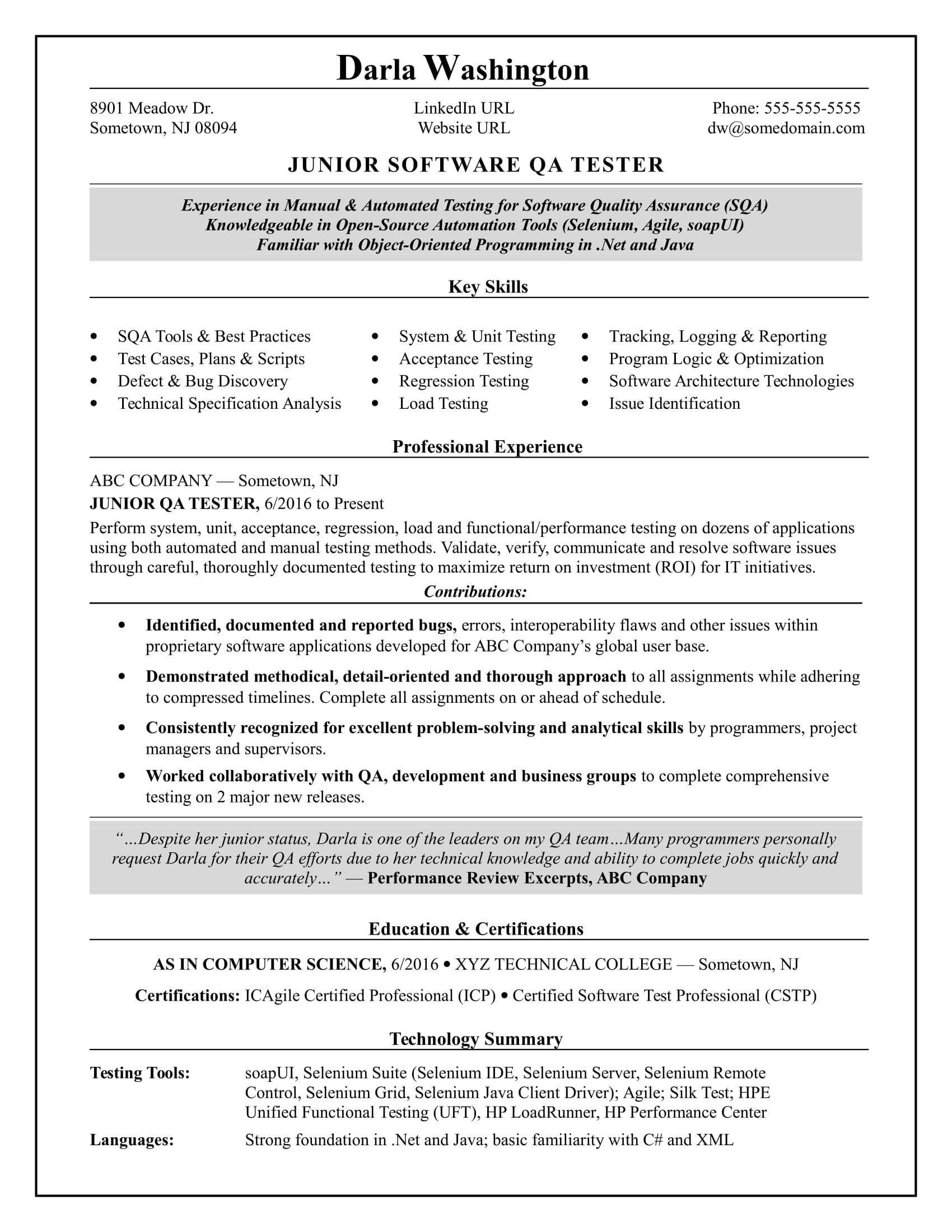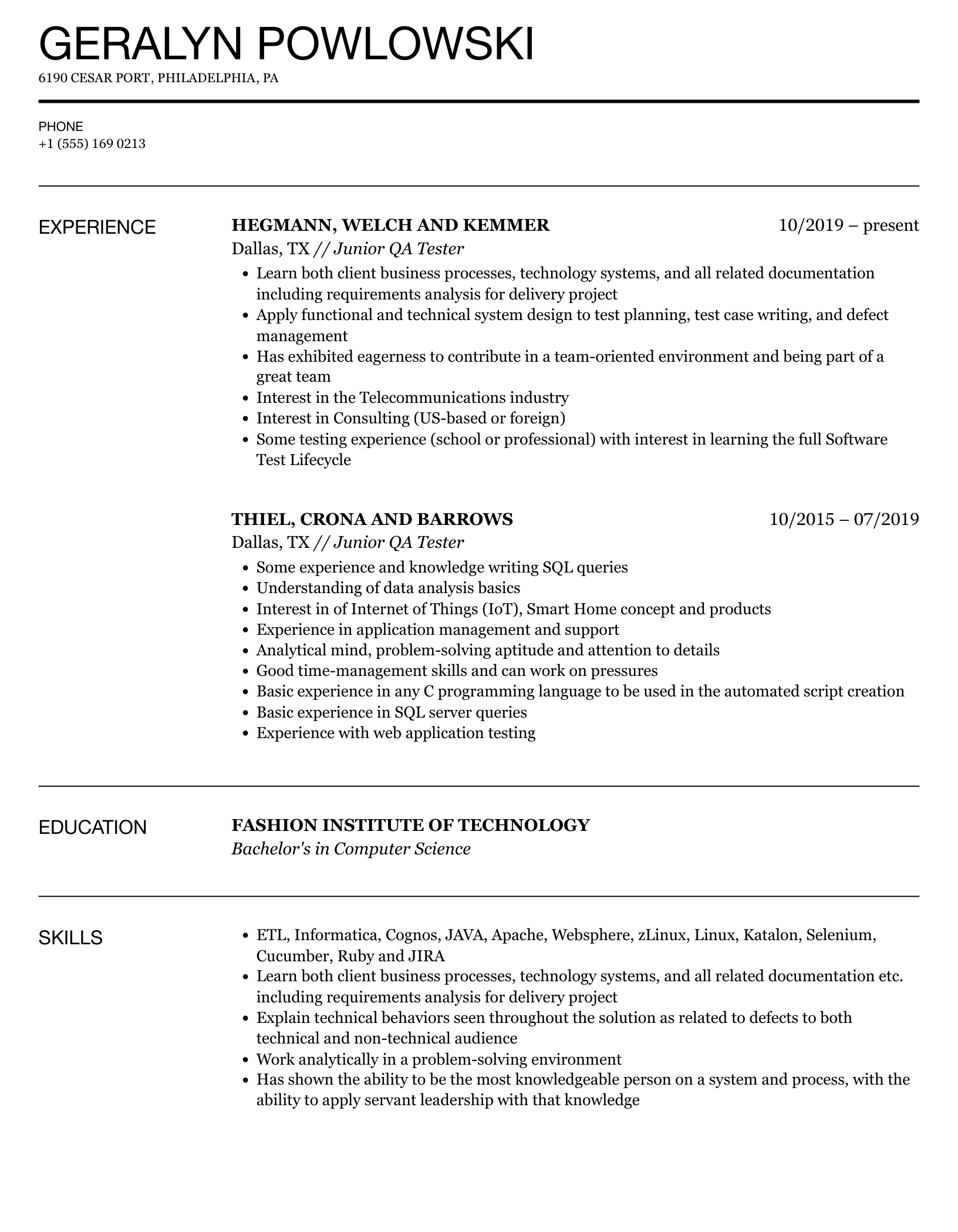Hey there, job hunters! If you're reading this, chances are you're diving headfirst into the world of QA testing and wondering how to craft a resume that'll blow recruiters away. A QA tester resume isn't just a document; it's your ticket to landing that dream job. So, let's roll up our sleeves and break down exactly what it takes to make yours stand out from the crowd.
Listen up, folks. The competition in the tech world is fierce, and hiring managers are swamped with resumes every single day. You need to make sure your QA tester resume is not just good but absolutely killer. It's all about showcasing your skills, experience, and achievements in a way that screams "hire me!"
And don't worry, we've got your back. This guide is packed with tips, tricks, and real-world examples to help you craft a resume that'll get you through the door and into the interview room. So, buckle up, because we're about to dive deep into the art of resume writing for QA testers.
Read also:Hdhub Movie 4u Your Ultimate Streaming Destination
Why Your QA Tester Resume Matters
First things first, let's talk about why your QA tester resume is such a big deal. Think of it as your personal sales pitch. It's the first impression you'll make on potential employers, and you want it to be a good one. A well-crafted resume can open doors, while a mediocre one can leave you in the rejection pile.
Here's the deal: hiring managers spend an average of just six seconds scanning a resume. That's right, six seconds. So, every word, bullet point, and design element counts. You need to make sure your resume is clear, concise, and packed with the right keywords to catch their eye.
Plus, in the QA testing field, it's not just about what you know but how you present it. Employers want to see that you're detail-oriented, tech-savvy, and capable of solving complex problems. Your resume is your chance to prove that you've got what it takes.
Key Components of a QA Tester Resume
Now that we know why your resume matters, let's break down the key components you need to include. Think of these as the building blocks of your resume. Each one plays a crucial role in showcasing your skills and experience.
Contact Information
Seems obvious, right? But you'd be surprised how many people forget to include their contact details. Make sure you've got your full name, phone number, email address, and LinkedIn profile front and center. This is how employers will reach out to you, so accuracy is key.
Professional Summary
This is your elevator pitch. In just a few sentences, summarize your experience, skills, and career goals. Think of it as a snapshot of who you are as a QA tester. Keep it short and sweet, but make sure it packs a punch.
Read also:Hdhub4u Marathi Movie Your Ultimate Guide To Marathi Cinema
Skills Section
Here's where you get to show off your technical chops. List out your hard skills like programming languages, testing tools, and methodologies. But don't forget the soft skills too—things like problem-solving, communication, and teamwork are just as important in the QA world.
Formatting Your QA Tester Resume
Formatting might not seem like a big deal, but trust us, it is. A clean, professional layout can make all the difference in how your resume is perceived. Here are a few tips to keep in mind:
- Use a standard font like Arial or Calibri—nothing too fancy.
- Stick to a consistent font size, usually between 10 and 12 points.
- Leave plenty of white space to make your resume easy on the eyes.
- Use bullet points to break up long blocks of text.
Remember, your resume should be easy to scan. If a hiring manager has to hunt for important information, they might just move on to the next candidate.
Highlighting Your QA Tester Experience
Now let's talk about the meat and potatoes of your resume—your experience. This is where you get to showcase your QA tester superpowers. Here's how to do it right:
Use Action Verbs
Action verbs are your best friend when it comes to describing your experience. Instead of saying "Responsible for testing software," try "Conducted comprehensive testing of software applications." It sounds more active and impressive.
Show Results, Not Just Duties
Employers want to see what impact you've had in your previous roles. Quantify your achievements whenever possible. For example, "Improved software performance by 25%" is much more compelling than "Tested software performance."
Tailoring Your QA Tester Resume
One size does not fit all when it comes to resumes. You need to tailor your QA tester resume for each job application. Here's how:
Match Keywords
Most companies use Applicant Tracking Systems (ATS) to screen resumes. These systems look for specific keywords related to the job description. Make sure your resume includes the right keywords to pass the ATS test.
Customize Your Summary
Your professional summary should reflect the specific job you're applying for. Highlight the skills and experience most relevant to that role. This shows the hiring manager that you've done your homework.
Education and Certifications
Education and certifications are important, especially in the QA testing field. Here's what you need to include:
Degree Information
List your relevant degrees, including the institution and year of graduation. If you've got a degree in computer science or a related field, make sure it's front and center.
Certifications
Any certifications you've earned should be prominently displayed. This could include things like ISTQB, CSTE, or any other relevant QA certifications. They show that you're committed to staying up-to-date in your field.
Additional Sections to Consider
Depending on your experience and qualifications, you might want to include additional sections in your QA tester resume. Here are a few ideas:
Projects
If you've worked on any notable QA projects, include them in a separate section. Describe the project, your role, and the results. This gives employers a deeper understanding of your capabilities.
Awards and Recognition
Have you received any awards or recognition for your work in QA testing? If so, make sure to highlight them. It's a great way to demonstrate your excellence in the field.
Common Mistakes to Avoid
Even the best resumes can fall flat if they're riddled with mistakes. Here are a few common pitfalls to avoid:
- Typos and grammatical errors—proofread, proofread, proofread!
- Going over two pages—keep it concise and to the point.
- Using overly complex language—stick to simple, clear language that everyone can understand.
Remember, your resume is your first impression. You want it to be polished and professional.
Getting Feedback on Your QA Tester Resume
Once you've drafted your resume, it's a good idea to get feedback from others. Ask colleagues, mentors, or even professional resume writers to review it. They can provide valuable insights and help you identify areas for improvement.
And don't be afraid to make changes. Your resume should evolve as your career grows. Keep it updated with your latest achievements and skills to ensure it's always ready for the next opportunity.
Conclusion
So there you have it, folks—your ultimate guide to crafting a killer QA tester resume. Remember, it's all about showcasing your skills, experience, and achievements in a way that resonates with hiring managers. Tailor your resume for each job application, highlight your results, and keep it polished and professional.
Now it's your turn. Take what you've learned and start building your dream resume. And don't forget to share this guide with your fellow QA testers. Together, we can all level up our resume game. Happy job hunting!
Table of Contents
- Why Your QA Tester Resume Matters
- Key Components of a QA Tester Resume
- Formatting Your QA Tester Resume
- Highlighting Your QA Tester Experience
- Tailoring Your QA Tester Resume
- Education and Certifications
- Additional Sections to Consider
- Common Mistakes to Avoid
- Getting Feedback on Your QA Tester Resume
- Conclusion


![4+ QA Tester Resume Examples [with Free Templates]](https://cdn.prod.website-files.com/627c8700df0be67c4b1d533c/657f54a4da303a85ac6dda9b_qa-tester-Resume-Sample.png)